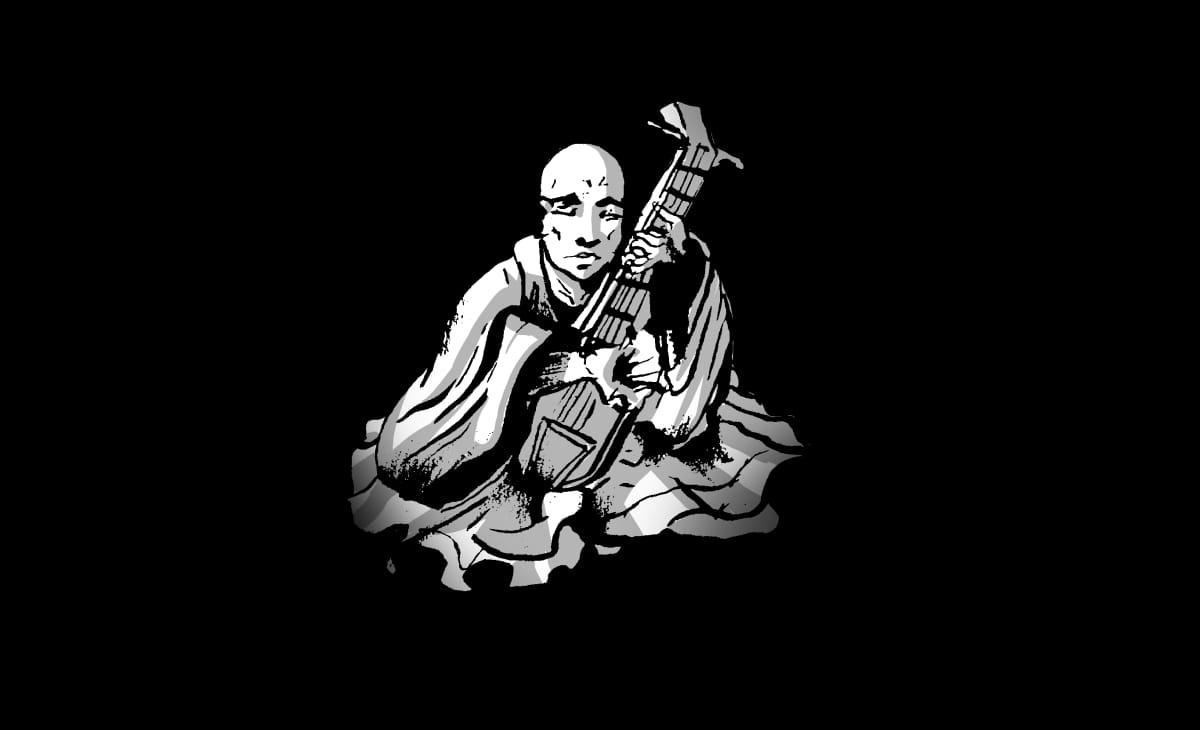“The past is a place of reference, not a place of residence; the past is a place of learning, not a place of living.”
Inspired by: the Japanese story of Hōichi the Earless

The tale of Hōichi the Earless
The biwa hōshi were lute performers – blind priests reciting poetry, literature, and telling stories of the past to the accompaniment of biwa music.
Hoichi was among the best of them, famous for performing The Tale of the Heike – a tragic story about the warriors of Taira and the death of their young emperor.
One night, a lone samurai visited Hōichi in his temple.
“I’m here to bring you to my lord, he’d heard about your skills and wants to see them in person.”
While a private performance for a rich noble wasn’t anything unordinary – a request coming in the middle of the night was.
But the warrior’s tone clearly wouldn’t accept refusal.
So Hōichi donned his robes, grasped his biwa, and followed the black-clad samurai.
He was led to a luxurious estate. He heard many figures moving at the edges of the hall but, being blind, couldn’t see any of them.
A voice echoed throughout the room, demanding the monk to perform the story about the gruesome fate of the Taira clan.
Hōichi plucked the first string, lifting the tension, and began his tale.
He told of the rebellion of the Minamoto clan, and the bloody battles that came with it.
He told of the Taira clan who fled to protect their emperor.
Finally, he told of their end – as their emperor and his grandmother threw themselves in the sea. Choosing death over capture.
When he finished his performance, weeps and cries filled the hall.
He was ordered to come back the next night and perform for the court once again.
The cycle kept repeating itself, and it wasn’t long until the head priest noticed Hōichi’s absence.
Worried – he ordered the servants to follow Hōichi during his next excursion.
They followed him to a nearby graveyard, where the biwa hōshi sat before the grave of Emperor Antok and started playing. A moment later, bright lights started circling his still figure.
The servants reported their findings to the high priest, who realized Hōichi was in great danger.
He called for him immediately, and explained that the nobles were actually ghosts of the fallen Taira clan, and, if provoked, would take his soul.
Knowing the spirits would come for him again, the priest painted symbols of the Heart Sutra over Hōichi’s body – rendering him invisible to the ghostly samurai.
When night came, the court’s servant stepped into Hōichi’s room, but he couldn’t find the young performer.
He grasped his blade and called out.
“Where are you Hōichi? Why are you hiding? I see your biwa, I know you are here!”
The monk stayed silent – the markings on his body would only protect him if he didn’t make a sound.
But in his hurry, the head priest forgot to cover Hōichi’s ears in the sutras.
And so the samurai noticed two ears floating in the air.
“Ah I see… Your body was taken away. Then I’ll have to simply take your ears to the court.”
He cut off Hōichi’s ears, but even with hot blood flowing down his head, the priest remained quiet.
The next morning, he was found unconscious in a pool of blood.
With servants quickly tending to his wounds, he survived the ordeal, and the ghosts of the Taira never visited him again.
The story only served to make him more famous. Thousands of people were lining up to see a performance that could move even the dead.
The tale of Hōichi the Earless still serves as a reminder of the power of stories, and the risks that come with interacting with the ghosts of the past.
Personal Updates
Hey, I’m doing a spontaneous solo trip to Mediolan today.
Finally, something to help me get out of my comfort zone, and build up some tolerance towards uncertainty.
Lately, I’ve been ruminating and overthinking too much, so let’s hope this trip is the first step towards changing that.
And if you happen to be from Mediolan… Definitely let me know!
Topic for next week: “Leshy – the Slavic Protector of the Forest”
Hope to see you there,
Łukasz Skoneczny


